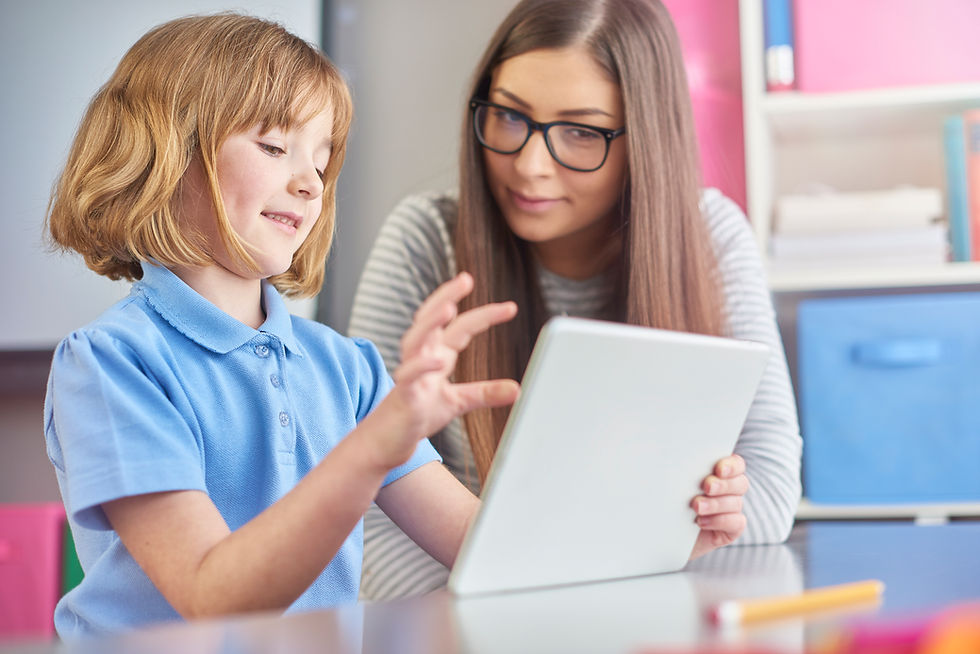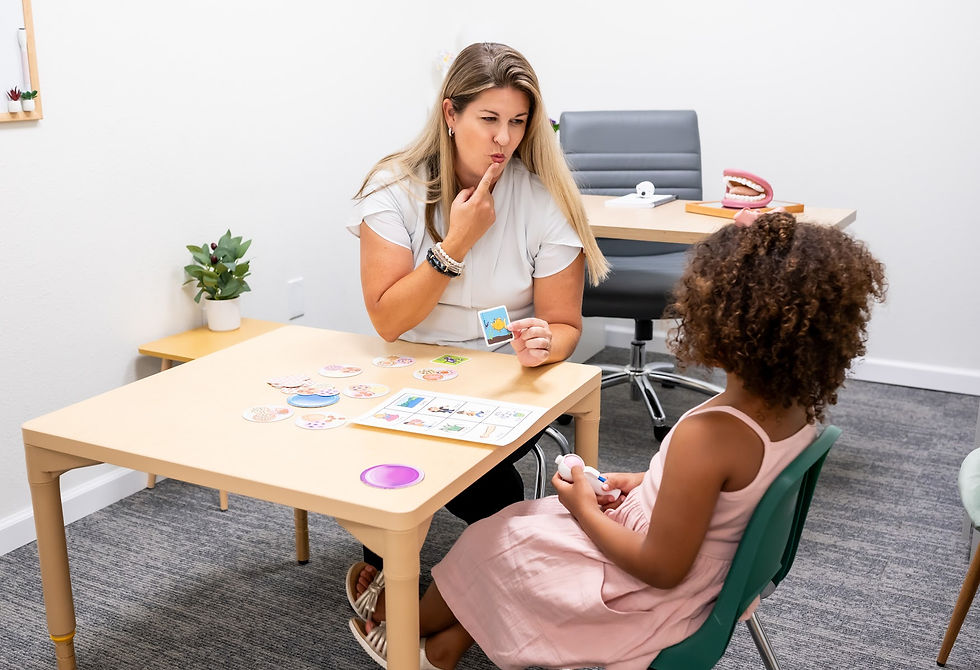Let’s Talk This Summer!
- Cara Bridge

- Jun 19
- 7 min read
Engaging Summer Activities to Boost Language Development in Toddlers

First, let’s talk about strategies to promote language. These are things Speech Language Pathologists (SLPs) use in their sessions every day that can be easily implemented at home.
Offering Choices
Instead of asking your child “Do you want this?” (leaving them with only yes and no as responses), offer your child a choice. This way you will give them a chance to use a variety of vocabulary words. Give your child two choices while naming both options - this way you are modeling the language and giving them a chance to use it.
Following their Lead
Get into your child’s world - follow their lead while you play together. Talk about what you see them doing, narrating their actions, and modeling the vocabulary - all while honoring their interests and how they want to play.
Copy and Add
This one is huge for our toddlers who are using one-word utterances. When your child gives you a one word response (i.e. “more”), copy what they said and add to it (i.e. “more blueberries” “more please”). Model, model, model.
Reducing Questions
Questions can be confusing for our children who are learning to talk. Instead of asking “what is this?” or “what color is it?”, try providing a comment or explanation - “Look, it’s a turtle!”, “The turtle is green.”, “Turtles are slow.”
Communication Temptations
Give your child the chance to communicate! As parents, we get into the habit of knowing what our children want before they tell us. Remember to give them a chance to tell us what they want - hand them a container you know they can’t open, “forget” to put their milk in the cup, put their favorite toy where they can’t reach it - give them the opportunity to ask for what they want.
Now that we know the strategies to use, where can we use them this summer?

The Playground
Making the playground fun while support communication, independence, and connection!
Offering Choices
Give your toddler simple, clear options to empower them and reduce frustration.
“Do you want to go on the slide or the swing first?”
“Do you want to ride your bike or ride in the stroller?”
“Should we climb the stairs or the ladder?”
Following Their Lead
Watch what your toddler is interested in, and join in without taking over.
If your child wants to play with the leaves on the ground, play with them - make comments like “big leaf”, “green leaf”, “uh oh leaves fall down”.
If your child wants to go down the slide, make it a game! “Ready, set… GO”, “slide fast!” “Let’s do it again!”
Copy and Add
Imitate what your child is saying, then add a small variation to expand their play or language.
If you child says:
Slide - you can say “slide fast!”
Jump - “jump high!”
Go - “go down”, “go fast”, let’s go”
Push - “push me” “push please”
Reduce Questions
Rather than asking too many questions (“What’s that? What color is it?”), offer comments or model words.
Instead of “What do you want to do now?” say, “You’re climbing! You’re so high!”
Instead of “Are you having fun?” say, “That swing is fast!”
Narrate what’s happening: “You’re going up… and down!”
Communication Temptations
Set up situations that encourage your child to communicate—without demanding it.
Hold the swing still and wait for them to look at you, gesture, or say “go!” before pushing.
Close a sandbox lid and wait—this gives them a reason to ask for help.
Put a favorite toy or snack just out of reach and wait for them to make a request or gesture.

The Pool or Splash Pad
Cool off this summer while also promoting language and building connections with your toddler.
Offering Choices
Help toddlers feel in control and encourage language by letting them choose between two things.
“Do you want to go to the sprinklers or the little slide?”
“Blue bucket or yellow watering can?”
“Do you want to splash or pour water?”
Follow their Lead
Notice what grabs your toddler’s attention, and join them in that activity without redirecting.
If your child loves the playing with water toys in the pool or splash pad - sit with them and comment on what they are doing
"Pour it in" "Dump it out" "Splash!"
Copy and Add
Imitate what your toddler does or says, then expand on it slightly to build their understanding and vocabulary.
If they stomp in water, you stomp too and say, “Stomp! Big splash!”
If they say “water,” you say, “Yes! Cold water!”
If they pour, you pour and add, “Pour it out!”
Reduce Questions
Rather than asking questions, describe what’s happening and model simple language.
Instead of “Do you want to go in the water?” say, “You’re going in! Splash splash!”
Instead of “What color is that?” say, “That’s a red bucket!”
Narrate actions: “You’re running in the water!” or “Water on your toes!”
Create Communication Temptations
Use playful obstacles or surprises to motivate your toddler to request, signal, or engage.
Hold their favorite toy - wait for them to ask or you can model "play / please / more"
Pour water slowly and pause—see if they ask for “more.” If not, model it.
Hand them the pool toys in a bag you know they can't open - wait for or model "open / help"

The Beach
Use everyday beach fun to support your toddler’s language and connection
Offer Choices
Give simple options to help toddlers express themselves and feel in control
“Do you want to dig with the shovel or scoop with the bucket?”
“Should we sit near the water or in the sand?”
“Do you want the red bucket or the green one?”
Follow Their Lead
Watch what your toddler is curious about—and join in!
If they’re walking along the water, go with them and talk about what they see.
If they’re playing with seashells, sit beside them and explore too.
Let them take the lead in digging, pouring, splashing, or exploring.
Copy and Add
Repeat what they do or say, and then expand a little to model new words or actions
If they splash the water, splash too and say, “Splash! Big splash!”
If they say “sand,” you can say, “Soft sand” or “Dig the sand.”
If they scoop the sand, you do it too: “Scoop scoop! Dump it out!”
Reduce Questions
Instead of asking too many questions, make simple comments to model language.
Instead of “What are you doing?” try “You’re digging a big hole!”
Instead of “What color is that?” say, “You found a white shell!”
Describe what they’re doing: “Water is cold!” “You’re running fast!”
Communication Temptations
Create playful situations that motivate your toddler to communicate
Hold the bucket just out of reach—wait to see if they say "bucket" or "play"
Put a favorite toy under the sand and act surprised when they uncover it - model "look!" or "help!"
Start pouring water from a bucket, then stop—wait to see if they ask for more.

Cooking a Meal Together
Daily routines like cooking are perfect opportunities to build your toddler’s language and confidence.
Offer Choices
Let your toddler make small decisions to promote independence and language
“Do you want to stir or pour?”
“Should we cut the banana or the apple today?”
“Red spoon or blue spoon
Follow Their Lead
Watch what interests your toddler in the kitchen and go with it.
If they reach for a bowl, let them help mix.
If they’re curious about a certain food, talk about it and let them touch or smell it.
If they want to taste ingredients, talk about what they’re trying: “That’s yogurt—cold!”
Copy and Add
Repeat your toddler’s actions or words, then build on them to expand language.
If they bang a spoon, you do it too and say, “Bang bang! Loud!”
If they say “egg,” you say, “Crack the egg!”
If they pretend to mix, mix too: “Mix mix!”
Reduce Questions
Instead of asking questions - use simple comments to model language and build vocabulary
Instead of “What’s that?” say, “That’s flour—soft and white!”
Instead of “Do you like it?” say, “You tasted it—mmm, sweet banana!”
Narrate what you’re doing: “I’m pouring milk. You’re stirring!”
Communication Temptations
Create natural reasons for your toddler to gesture, look, or talk.
Hold the next ingredient and wait—see if they reach, point, or ask.
Put the lid on a container and hand it to them (so they need help opening).
Start mixing and pause—wait to see if they say “more” or “go.”

Bath Time
Bath time is more than getting clean—it’s a perfect chance to connect and help your toddler learn new words and communication skills.
Offer Choices
Give your toddler small, simple choices to help them express themselves and feel confident.
“Do you want the duck or the cup?”
“Wash your feet or your hands first?”
“Purple towel or yellow towel?”
Follow Their Lead
Watch what your toddler is interested in and join in the fun
If they’re splashing, splash too and talk about it!
If they’re filling and dumping a cup, you can do the same beside them - model words like "pour" or "uh-oh"
If they want to wash their doll or toy, join in and narrate what’s happening.
Copy and Add
Imitate what your toddler says or does, then add a little to build language
If they say “splash,” you say, “Big splash!”
If they pour water, you do it too and say, “Pour it out—whoosh!”
If they make sounds like “brrr,” copy it and add, “Brrr, cold water!”
Reduce Questions
Model language with fun, simple comments
Instead of “What’s that?” say, “That’s your boat! It’s floating!”
Instead of “What are you doing?” say, “You’re washing your toes!”
Use short sentences: “Drip drip!” “All clean!”
Communication Temptations
Set up small challenges that motivate your toddler to communicate with looks, gestures, or words
Hold a favorite toy just out of reach—wait for them to ask for "help"
Pause while pouring water on a toy—wait to see if they say “more”
Put bubbles in your hand, show them, and wait before blowing - see how they respond.





Comments